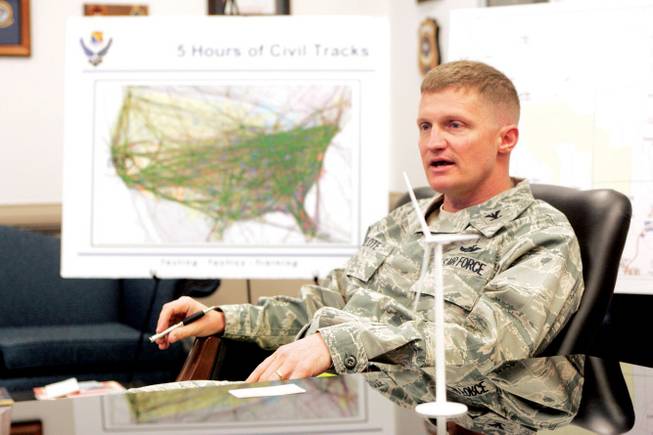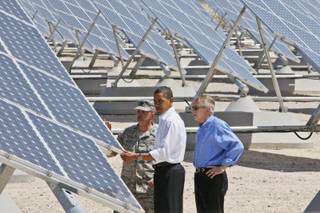
Nellis Base Commander Col. Howard Belote says the process of siting a green project near military installations needs to be streamlined.
Friday, Jan. 8, 2010 | 2 a.m.
Related stories
- NV Energy agrees to purchase Crescent Dunes solar power (12-22-2009)
- The cost of building a solar powered economy (8-16-2009)
- Interior bets big on Western solar energy (7-3-2009)
- Obama, Reid tour Nellis solar facility (5-27-2009)
- Solar developers shoot to beat buzzer for cash (3-22-2009)
Sun Coverage
Even if it didn’t have high-powered weaponry, the Air Force would have to be reckoned with in Nevada.
It directly and indirectly employs thousands of state civilians and controls much of the land.
But military interests have run smack into those of the nation’s most powerful politicians and the industry touted as Nevada’s potential financial savior.
Renewable energy companies want to fill the state’s desert with solar arrays and dot its peaks with wind turbines. They would create hundreds of short-term construction jobs, lease income for cities and the federal government, and emission-free energy.
This would all be well and good if the towers associated with solar thermal and wind power plants didn’t cause problems for systems central to the training and tests taking place on Nevada’s military bases.
Wind turbines can mess up weather and weapons tracking radar and interfere with tests of new radar-evading equipment and tactics. If Nellis Air Force Base gets a false read from a test because a solar tower interfered with the electromagnetic field of its radar sensors, it could lead to the military formulating a doomed military tactic.
“We’re walking a tightrope between military readiness and energy independence,” Nellis Base Commander Col. Howard Belote said. “We know the Nevada Test and Training Range is ringed with high voltage solar and wind potential areas, we’re very sensitive to that, but we have to be able to fulfill our mission.”
Nellis has a history of smacking down renewable energy projects near its test range. Though developers aren’t required to clear their plans with the military before proceeding, the military can object to a location — and squash a project — early in the Bureau of Land Management evaluation stage.
The Air Force in 2002 killed a wind plant proposed for the Nevada Test Site. And last year Nellis officials butted heads publicly with solar developer SolarReserve over the company’s proposal to build a solar thermal plant with a 600-foot-tall tower at Mud Lake just outside the Air Force training range in Nye County.
Developers planning these projects likely spent millions of dollars on site studies before choosing their ill-fated plots of land. SolarReserve did not return calls and e-mails seeking comment.
But the days of simply crushing any project it thinks might pose a problem are gone, Belote said.
After a sometimes contentious 16-month negotiation with SolarReserve, intervention from Senate Majority Leader Harry Reid, extensive analysis by the Air Force Scientific Advisory Board and a visit to the Nellis Solar Photovoltaic array by President Barack Obama, the military has broadened its linguistics skills to include a new language: energy geek speak.
SolarReserve’s planned 100-megawatt solar thermal plant is slated for land farther west, near Tonopah, and is undergoing a BLM environmental impact review with the Air Force’s blessing.
Getting this far wasn’t easy, but Belote and others familiar with the process said it taught the military and renewable energy developers a lot about each other and paved the way for future projects near military installations. Renewable developers now have access to better information about where the Air Force won’t welcome their towers.
Airspace Nellis uses for tests and training is far larger than the borders marked on land maps. The airspace issue was never a problem when the most technologically advanced equipment on the ground were off-road vehicles and alfalfa harvesters. But the massive airspace over Nevada where commercial flights are banned demonstrates how many millions of acres could be potentially off-limits for renewable energy projects dependent on towers.
The lessons are important because they don’t just apply here. There are dozens of renewable energy projects planned for Nevada soil, but the issues that arose at Mud Lake could just as easily arise near bases in California or Oklahoma. With financing tough to obtain and a rush on the best public land near transmission lines, it’s tough enough to get a project off the ground without angering the Air Force.
“This isn’t the biggest challenge for renewables in the West, but it must be further addressed in the very near term to provide projects more certainty,” Reid’s spokesman Jon Summers said.
Renewable energy developers now know they need to talk to the Air Force very early on if they’re considering a site anywhere near the test range. Belote said he would prefer they talk to him when the plant is a “twinkle in their eye.”
While the Air Force and developers hope the process will be streamlined, it could still take months to negotiate a site for a tower solar plant or commercial wind farm near a base. The developer can’t apply for a right of way to lease land from the Bureau of Land Management until it has a site in mind. Late-stage delays or changes in the proposed location stemming from objections from the Air Force or others could cost a developer millions of dollars.
But it could also turn into a publicity nightmare for the military.
“We have a choice: We can be a speed bump or a partner,” Belote said. “We’re trying very hard to be a partner. Renewable developers, BLM and DOD can work incredibly effectively as a team as long as we have early communication.”
Reid’s office said there is much work to be done on a national level before the military can produce answers as quickly as Reid would like. Summers said the Defense Department needs a high-level person to oversee the process for reviewing renewable energy projects near military installations and to lead the department in identifying ways to mitigate impacts these projects might have on military functions.
Belote wants to see a system that eliminates the need for renewable developers to juggle the needs of several agencies at once. He’s traveled the country talking to the renewable energy industry, politicians, chambers of commerce, BLM officials and military peers about finding out how to make the negotiation process more efficient.
He would like to see more resources for the Air Force to analyze location proposals from renewable energy developers. But he’d also like to see the creation of an interagency unit at the federal level to analyze proposed renewable energy project locations — one that would reveal potential impacts on the military, on endangered species, on Native American sites — before the company submits an application to the BLM.
For an organization with a computer system that coordinates flight plans and movements of hundreds of airplanes in military exercises, a computer modeling system that could take GPS coordinates from a developer and spit out an impacts report in minutes doesn’t seem so far-fetched.
“They need to create a better, more comprehensive screening process,” Belote said. “That would make things easier on everybody.”


Join the Discussion:
Check this out for a full explanation of our conversion to the LiveFyre commenting system and instructions on how to sign up for an account.
Full comments policy